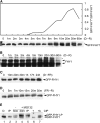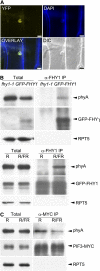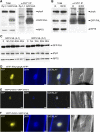Phytochrome A mediates rapid red light-induced phosphorylation of Arabidopsis FAR-RED ELONGATED HYPOCOTYL1 in a low fluence response
- PMID: 19208901
- PMCID: PMC2660616
- DOI: 10.1105/tpc.108.061259
Phytochrome A mediates rapid red light-induced phosphorylation of Arabidopsis FAR-RED ELONGATED HYPOCOTYL1 in a low fluence response
Abstract
Phytochrome A (phyA) is the primary photoreceptor for mediating the far-red high irradiance response in Arabidopsis thaliana. FAR-RED ELONGATED HYPOCOTYL1 (FHY1) and its homolog FHY1-LIKE (FHL) define two positive regulators in the phyA signaling pathway. These two proteins have been reported to be essential for light-regulated phyA nuclear accumulation through direct physical interaction with phyA. Here, we report that FHY1 protein is phosphorylated rapidly after exposure to red light. Subsequent exposure to far-red light after the red light pulse reverses FHY1 phosphorylation. Such a phenomenon represents a classical red/far-red reversible low fluence response. The phosphorylation of FHY1 depends on functioning phyA but not on other phytochromes and cryptochromes. Furthermore, we demonstrate that FHY1 and FHL directly interact with phyA by bimolecular fluorescence complementation and that both FHY1 and FHL interact more stably with the Pr form of phyA in Arabidopsis seedlings by coimmunoprecipitation. Finally, in vitro kinase assays confirmed that a recombinant phyA is able to robustly phosphorylate FHY1. Together, our results suggest that phyA may differentially regulate FHY1 and FHL activity through direct physical interaction and red/far-red light reversible phosphorylation to fine-tune their degradation rates and resulting light responses.
Figures







Similar articles
-
FAR-RED ELONGATED HYPOCOTYL1 and FHY1-LIKE associate with the Arabidopsis transcription factors LAF1 and HFR1 to transmit phytochrome A signals for inhibition of hypocotyl elongation.Plant Cell. 2009 May;21(5):1341-59. doi: 10.1105/tpc.109.067215. Epub 2009 May 29. Plant Cell. 2009. PMID: 19482971 Free PMC article.
-
FHY1 and FHL act together to mediate nuclear accumulation of the phytochrome A photoreceptor.Plant Cell Physiol. 2006 Aug;47(8):1023-34. doi: 10.1093/pcp/pcj087. Epub 2006 Jul 22. Plant Cell Physiol. 2006. PMID: 16861711
-
Arabidopsis FHY1 and FHY1-LIKE Are Not Required for Phytochrome A Signal Transduction in the Nucleus.Plant Commun. 2019 Nov 9;1(2):100007. doi: 10.1016/j.xplc.2019.100007. eCollection 2020 Mar 9. Plant Commun. 2019. PMID: 33404546 Free PMC article.
-
Light perception and signalling by phytochrome A.J Exp Bot. 2014 Jun;65(11):2835-45. doi: 10.1093/jxb/ert379. Epub 2013 Nov 12. J Exp Bot. 2014. PMID: 24220656 Review.
-
Regulation of Plant Photoresponses by Protein Kinase Activity of Phytochrome A.Int J Mol Sci. 2023 Jan 20;24(3):2110. doi: 10.3390/ijms24032110. Int J Mol Sci. 2023. PMID: 36768431 Free PMC article. Review.
Cited by
-
A PP6-type phosphatase holoenzyme directly regulates PIN phosphorylation and auxin efflux in Arabidopsis.Plant Cell. 2012 Jun;24(6):2497-514. doi: 10.1105/tpc.112.098905. Epub 2012 Jun 19. Plant Cell. 2012. PMID: 22715043 Free PMC article.
-
Low-fluence red light increases the transport and biosynthesis of auxin.Plant Physiol. 2011 Oct;157(2):891-904. doi: 10.1104/pp.111.181388. Epub 2011 Aug 1. Plant Physiol. 2011. PMID: 21807888 Free PMC article.
-
FAR-RED ELONGATED HYPOCOTYL1 and FHY1-LIKE associate with the Arabidopsis transcription factors LAF1 and HFR1 to transmit phytochrome A signals for inhibition of hypocotyl elongation.Plant Cell. 2009 May;21(5):1341-59. doi: 10.1105/tpc.109.067215. Epub 2009 May 29. Plant Cell. 2009. PMID: 19482971 Free PMC article.
-
Evidence that phytochrome functions as a protein kinase in plant light signalling.Nat Commun. 2016 May 13;7:11545. doi: 10.1038/ncomms11545. Nat Commun. 2016. PMID: 27173885 Free PMC article.
-
Molecular mechanisms underlying phytochrome-controlled morphogenesis in plants.Nat Commun. 2019 Nov 19;10(1):5219. doi: 10.1038/s41467-019-13045-0. Nat Commun. 2019. PMID: 31745087 Free PMC article. Review.
References
-
- Ahmad, M., Jarillo, J.A., Smirnova, O., and Cashmore, A.R. (1998. b). The CRY1 blue light photoreceptor of Arabidopsis interacts with phytochrome A in vitro. Mol. Cell 1 939–948. - PubMed
-
- Al-Sady, B., Ni, W., Kircher, S., Schafer, E., and Quail, P.H. (2006). Photoactivated phytochrome induces rapid PIF3 phosphorylation prior to proteasome-mediated degradation. Mol. Cell 23 439–446. - PubMed
Publication types
MeSH terms
Substances
Associated data
- Actions
- Actions
- Actions
Grants and funding
LinkOut - more resources
Full Text Sources
Molecular Biology Databases
Research Materials

